David Shukman of the BBC claims that “The weed so familiar to many of my generation was characterised by a relatively balanced amount of THC and CBD” when compared to today’s hybrid strains. This is true only of traditional hashish from regions such as Afghanistan, Morocco, Lebanon and Nepal.
Because old-fashioned cannabis resin (‘hash’) is made from landraces which have been selected for resin production and had little selection for potency, it does indeed often exhibit something approximating a balanced 1:1 THC:CBD ratio. But even back in the ’60s and ’70s, an era in which we are told cannabis was a more innocent and far gentler plant, there was plenty of imported pot in which CBD was often more or less absent and THC levels could be very high. Typically, this took the form either of refined cannabis oil or—more usually—of high quality ganja, meaning cured unseeded or lightly seeded flowering tops from the tropics and subtropics – ‘Thai Stick’ and the like.
In Thailand, Malawi, or regions such as South India, the strains of cannabis that have been grown for centuries to produce ganja most often produce only minimal quantities of CBD and can even exhibit levels of THC comparable to those of so-called ‘skunk’. Back in the hippie heyday, such pot was given informal underground brands like ‘Swazi Red’ or ‘Colombian Gold’.
In 1975 and 1976 the Laboratory of the Government Chemist reported Thai with as much as 17% THC—and that was after the bud had spent months on boats reaching England. THC levels such as this are far from unusual in Southeast Asia. In the ganja growing heartlands along the Mekong River generations of farmers have provided a continuous selective pressure for potency. Traditionally, a key part of the cannabis economy in Thailand and Laos is said to have been formed by specialists who produced high-quality seed, which was then supplied to farmers. The best of any season’s harvest would come from such fields. Similarly, in the Imphal Valley of Manipur, farmers and home growers know to keep seeds from good (i.e., potent) batches of ganja for sowing the following season. On an early collecting trip to Manipur, for example, I found a householder who only relucantly parted with seed from a standout plant. Growers who know this batch can attest to how potent the best individuals were.
Clearly the selective pressure in traditional ganja growing is less intensive than that of the modern so-called ‘clone’ method for breeding skunk, in which selected ‘mother plants’ can be kept indefinitely under 24-hour light regimes. However, the cumulative effect over generations of traditional ganja farming can result in very strong cannabis that’s often in any meaninful sense devoid of CBD. Analysis of samples from tropical India indicates that CBD is typically absent—even in some of the milder Bengali strains. This was the case in the ’60s and remains so today. Regarding THC levels, further evidence that the potency of modern hybrids is far from unprecedented comes, once again, from British seizures. In the words of the Home Office, as recorded in Hansard:
The latest data from the Forensic Science Service Ltd (FSS) show that the average tetrahydrocannabinol (THC) content of mature flowering tops from plants, otherwise known as sinsemilla, seized and submitted to the FSS from the 1 January 2008 to the present day was 14.0%. By comparison, during the same period, the average THC content of traditional imported cannabis and cannabis resin was 12.5% and 5.5% respectively.
On average, skunk (the FSS called it ‘sinsemilla’) showed only 1.5% more THC than ganja. So much for many times more potent. And, importantly, only in hashish would THC have been offset by a similar quantity of CBD.
In fairness, the BBC’s reporting on cannabis does seem to be improving. But—even if unwittingly—Aunty is still feeding the skunk hysteria.
Postscript:
Looking again at the LGC data I see that in ’78 a sample of Indian cannabis resin showed 26% THC. Customs bagged a 16% THC batch of Moroccan resin in ’75, and a shipment of Pakistani resin with the same strength in ’78. And then there are the concentrated extracts—‘hash oils’—with Indian, Kenyan and Pakistani samples all hitting around 40% THC. Simple extracts of this potency need to be made from starter material with a high cannabinoid content. The most potent was 48% THC oil from India seized in 1975. This is likely to have been prepared from tropical ganja plants rather than northern, Himalayan charas landraces.
The LGC does make the important point that “Cannabis resins normally had higher THC contents than most herbal material…”. Typically, the ‘herbal cannabis’ reaching UK shores during this era was of fairly low potency—mid to low single figures THC—either because it was from poor stock, or had degraded en route. This does, to be fair, support the kind of line Shukman is taking, though not the current media focus on CBD. Historically, ganja is most unlikely to have contained CBD in any relevant quantity. Some of the best bud to reach Britain in the ’70s appears to have been coming from southern Africa, such as Rhodesia—now Zimbabwe—with a sample hitting 12%. Nigerian and South Indian ganja seizures were milder, at 7.4% and 7.8%—less potent, but still typically without any meaningful quantity of CBD.
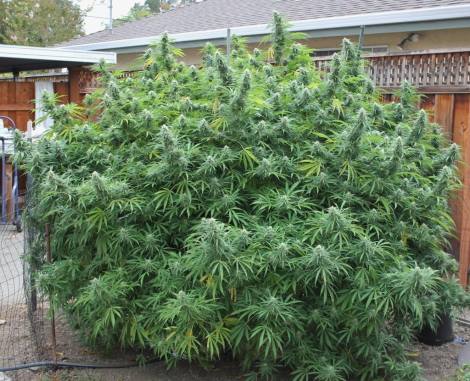
Manipuri ganja landrace in full flower, Imphal Valley, Northeast India
Should Thai ganja be seen as exceptional? Perhaps for this era in the UK it should, though both the proportion of samples available from seizures and ample anecdotal evidence suggest there was plenty of it about in the country, in addition to the stronger resins and concentrated oils. The LGC points out the unique appearance of the “Thai Stick” brand: “Green or brown sticks of several seedless tops tied around bamboo with a number of sticks compressed into a slab.” I’m sure there are readers who recognise this, either from having seen the real thing back in the day or on their travels.
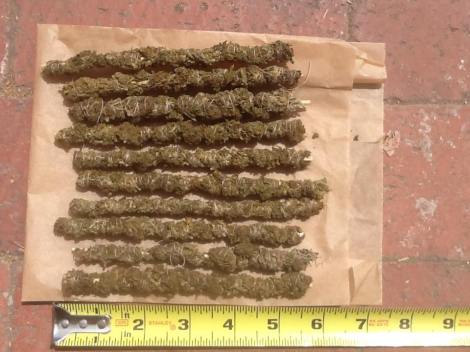
Thai sticks, as shared on Facebook by Peter Maguire, author of Thai Stick: Surfers, Scammers, and the Untold Story of the Marijuana Trade
The LGC figures suggest that the potency of Thai seizures peaked in the early to mid ’70s, and then began to decline after the Vietnam War and the Fall of Saigon. It’s not clear whether this sample is indicative of changes at the source in Isan, Northeast Thailand. But as the authors state, in ’75 and ’76 “by far the highest quality cannabis originated in South East Asia (exclusively in the form of “Thai sticks”) and this was reflected in its street price, at least in the United Kingdom, over the same period. However, the 1978 seizures which originated in Thailand, while still prepared in the form of sticks, showed a dramatic decrease in THC level compared with previous years. A careful study of the physical appearance of seizures of Thai origin for the three years revealed an increasing seed content in the cannabis.”
To take a contrarian line, perhaps the changes that have occurred in the UK over the last two decades are about catching up to highs the market, and its consumers, had already reached in 1975.
The featured image on the homepage is via the authors of a superb new book, Thai Stick: Surfers, Scammers, and the Untold Story of the International Marijuana Trade.
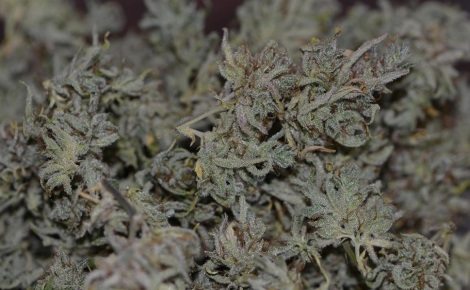
‘Mango Thai’, a Lao ganja landrace from Vientiane Province, grown indoors

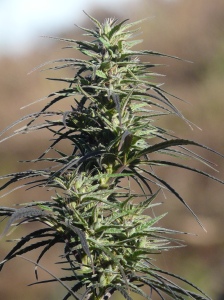
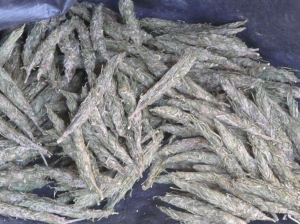
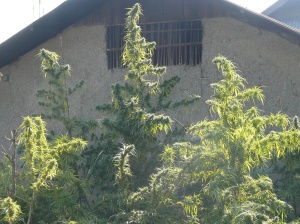
Reblogged this on drgreenthumbcannabislounge and commented:
check this out!
Quite right. Good article.
And all you have to do is travel and you will see that the old strains still available around the world are just as strong as the new strains available in wetern nations.
The other funny thing about this is that Australia and the USA smoke this stuff too but Britain is the only one having a skunk freak out.
Excellent info, very fair, and well set out. Anyone who’s read any of Dr O’Shaughnessy’s reports knows it was just as strong back in the day.
http://www.druglibrary.org/schaffer/history/e1850/gunjah.htm
Great article, I tweeted it to the BBC man himself.
It’s 99% Psychiatry propaganda. Cannabis would help destroy Psychiatry, and this sure draws the attention away from the fact they are biggest abusers of children eg the millions of kids on ADHD drugs, that have caused 1 million cases of bi-polar disease! http://whale.to/drugs/robert_whitaker_interview.html
Not to mention the Nutritional Medicine cures for Schizophrenia and addiction.
Pingback: ‘Skunk’ – What the funk? Let’s debunk | The Domestic Extremist·
Thanks for sharing!
Yep the dangers of high potency cannabis ‘issue’ is a total red herring useful only for feeding the neo-reefer madness going around these days.
I smoked great Thai weed back in the mid seventies, there were also great Columbian strains as well some very decent Red, Gold, and Rainbow. Thai eventually became stickless but the potency was still very high. Remember one particularly memorable batch which was called Buddha Stick. Quite dark with a few huge mottled seeds, large with an eighth or more on each stick. Remarkable stuff from around 1980.
Yes, discussion around the issue of potency has always been confused. It’s not just a modern Western thing either. Historically, the perception in India has been that charas (hashish) is the great danger. Second in order of evilness was ganja. By contrast, bhang was seen as far safer. Yet if you look at the doses a bhang eater consumers compared to a typical charas smoker, I bet just as much THC gets eaten or drunk when someone takes a dose of bhang.
Great to hear about 70s and 80s Thai ganja – the Buddha Stick brand was also used in Australia in the 90s.
Pingback: 10 Quick Questions with The Real Seed Company | The Real Seed Company Blog·
Pingback: Landraces: Myth-Busting Wild Cannabis and Traditional Strains | The Real Seed Company Blog·
Pingback: Grassyou interviews Angus from The Real Seed Company | The Real Seed Company Blog·
back in the day when I started smoking dope, one could find some wicked Congolese weed, very moist and super cured, that got me fucked up and hallucinated as well as today’s strains, which all feel the same at the end of the day (not bad, but similar). Back then, a Kerala COULD NEVER be mistaken for Durban Poison, Columbia Gold, Lambsbread, Acapulco Gold. Each strain had its own identity and its own way of making you fly. Now, almost all the weeds I’ve tasted in recent years in Holland, Cali, etc… taste and feel similar (notice how it is where the stuff is legal that it is increasingly “manufactured” for the masses). The only time I’ve felt something different and “old school” was with stuff that was homegrown, left alone and certainly not doped to maximize yield, potency and so forth. Sometimes I think that legalization was a bad thing and that we should have just decriminalized use.
hi – yes, it’s ever increasing homogeneity. The more people hybridise everything, the more it all becomes the same. This is quite literally happening at the genetic level – continual loss of biodiversity the more everything gets crossed and crossed.
About legalization: whether it turns out to be a good or bad thing all depends on whether it’s done sensibly or not. Potentially, a lot of good can come from it in the most important areas, ie for health, breeding, small farmers, consumers
Dropped right off after Vietnam? Hm… It’s almost like the bankers are stealing every bit of taxation in order to service the interest they imagined up into existence (to benefit us all of course) and had to outlaw drugs in order to create a monopoly so their clandestine intelligence assets could fund the services those taxes were supposed to pay for (along with supplementation from frack leases and student loans of course) with an innocent little bake sale. (Maybe we could even help revolutionaries we like with the extras!). They had a convenient hub in southeast Asia just brimming with black ops murderers they created who would do literally anything massa says, working with free transport and virtually free product… And then, all those ungrateful hippies smoking that good shit ruined it all for everyone by refusing to be murderers and protesting. No more Lao for y’all. How’s about we give U miss exclusive rights to breed in the USA, have them make something terrible that tests around 4-6%? Then we’ll have the DEA give it to their friends in the various Mexican drug cartels and have them make that bullshit the bedrock of American genetics. THC dominant, but magic free. Almost like that huh? Glad that didn’t happen. Oh. Wait. Shit.
Hi Glen, great to see you here
The numbers of seizures from Thailand / Laos analyzed by the LGC aren’t large enough to draw any dramatic conclusions from regarding the big picture imo, albeit they do indicate broadly how potent good tropical bud could be in the pre modern hybrid era
What would explain a decline in quality of imported product is much simpler than you suggest imo, namely that US funding and increased enforcement by Thai gov led to break up of north Isan scene – the brokers, farmers, and their customers…. Quality suffers under this type of pressure
Add to that, by mid 70s “import substitution” was underway, ie production for US was happening within US…. Less interest from outside buyers in Thailand, plus quality production shifting elsewhere within country such as to the far north and west
Clearly one of the big problems for democracies these days is concentrations of capital (super rich, finance system) rotting free societies. And it is well known that illicit drug money is tapped into by the spy world. But I’m very wary of looking to grand explanations when simpler ones will do. That Alfred McCoy book is not well supported afaik, or certainly not as regards the cannabis trade. Anti communist Lao generals did make use of planes to fly ganja around, but not afaik as part of a grand scheme to bring down the Pathet Lao communists…. (Perhaps Laos would have benefited if they had, however….)
Thanks for the reminder that there’s indeed more than one psychopath in power, machinations galore (seems the job prerequisite), each moving that chessboard around. Lol. Sometimes certain assholes seem a little more in control of the situation than is probably reality to my autistic mind. Markets truly drive a lot of it. Occasionally a picture as I described above comes into my head rather clearly. Some of it most definitely is true. I should know. The rat bastards used me as an unwitting guinea pig and asset as kid. When I later as an adult told the fbi (and that it goes all the way to Pennsylvania ave and right over to their handlers on wall street), the agent said, “We know. Some of us are still real”. They’d ended up telling me all sorts of nuggets. Like Clinton paid his dues as Bush Sr ‘s (who ran Reagan like a sock puppet) coke importation and money laundering specialist during Iran\contra. Those were actually the revolutionaries I’d had in mind. Though I have to imagine the real list is vast and started long before even the mujahideen. I imagine the first Roosevelt probably sprinkled them all over South America, walking around with his stick. Saddest of all they made the communists. Russia never could have done shit during the cold war without the West backing them for want of a bogey man. Ford built their plants. The Dutch/Danish I forget which, maybe Belgium (with NATO permission) built their ship’s diesels so the communists could even transport missiles to Cuba. They (my crooked government) bring in not only planes of that vile crack garbage (I’ve sampled many a material, but never fresh leaf. I imagine it’s wonderful stuff), but tankers. And everything else. They told me because they’d been running an LD 99.9 protocol on me and didn’t really expect me to survive. Found that out later when they realized I just basically can’t OD. It’s not like anyone outside of the big lie believes me. When medical went through in a few states, they had a falling out with sina loa over just who bungled their monopoly (triggering a hostile corporate takeover. The cops and judges are so, so very mad about losing their grift), and my oh my did the cartel start rolling on the senators on their payroll. Lol. Although you know, I do not recall them being punished… But before that point, I swear they’d been messing with potency. The Mexican imports were indistinguishable from the Umiss “research” trash at one point. All so they could make another bit of reefer madness (like this skunk paranoid delusion of grandeur) I assumed. Before 1995-96 though, my God was Mexican dope ever the shit. Some batches were absolutely incredible. But the idea that modern breeders have improved anything is absolute absurd nonsense. I assume you know of Angus cattle? As if our modern cattle could remotely compete with highland Angus on per hectare efficiency. Cannabis is no different. The elders are wise. The young uns are stupid. And I’d absolutely shit gold bricks if a goat herder hadn’t consumed something over 20% (and possibly 3% thcp for all we know) before Alexander the great walked the Earth.